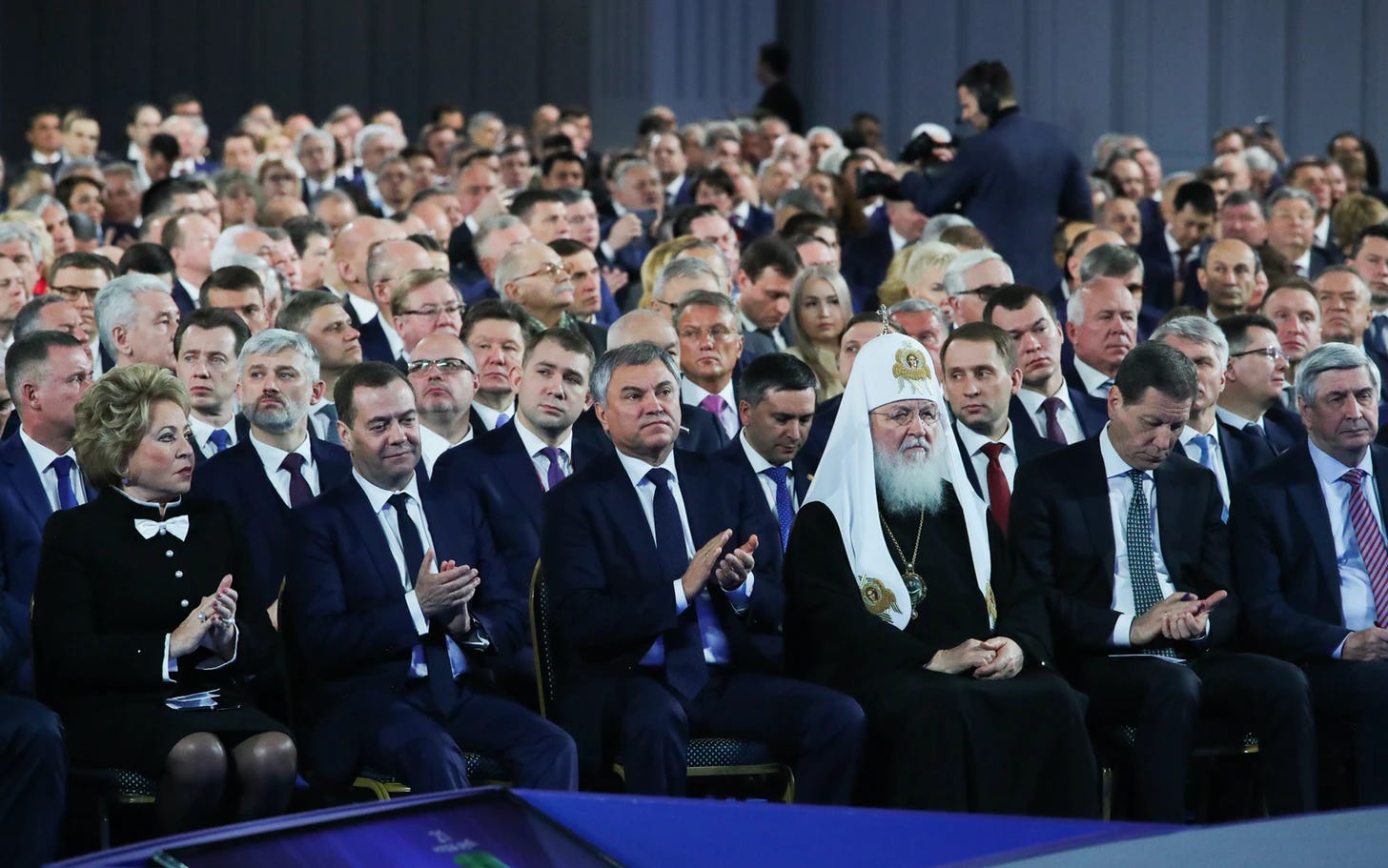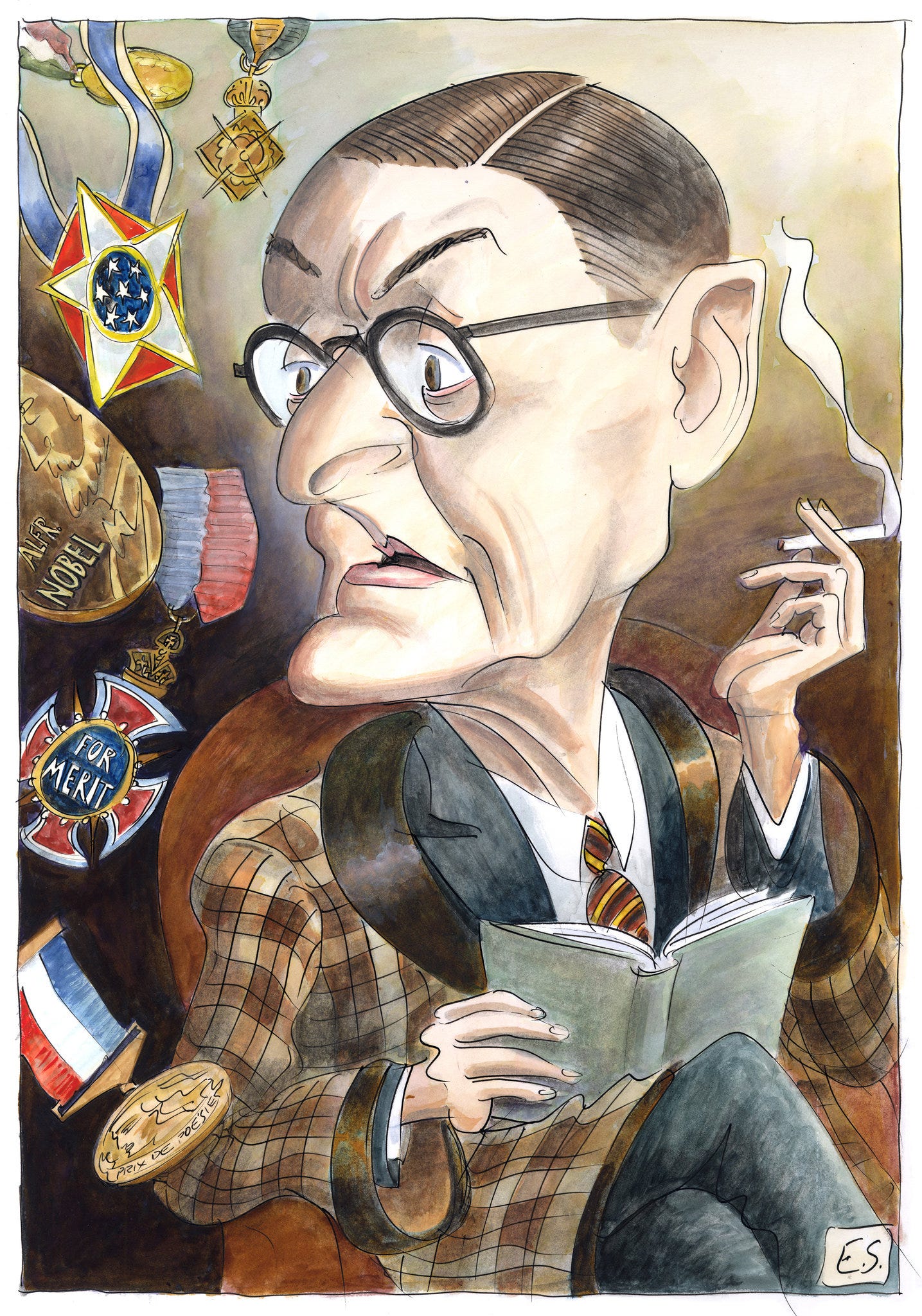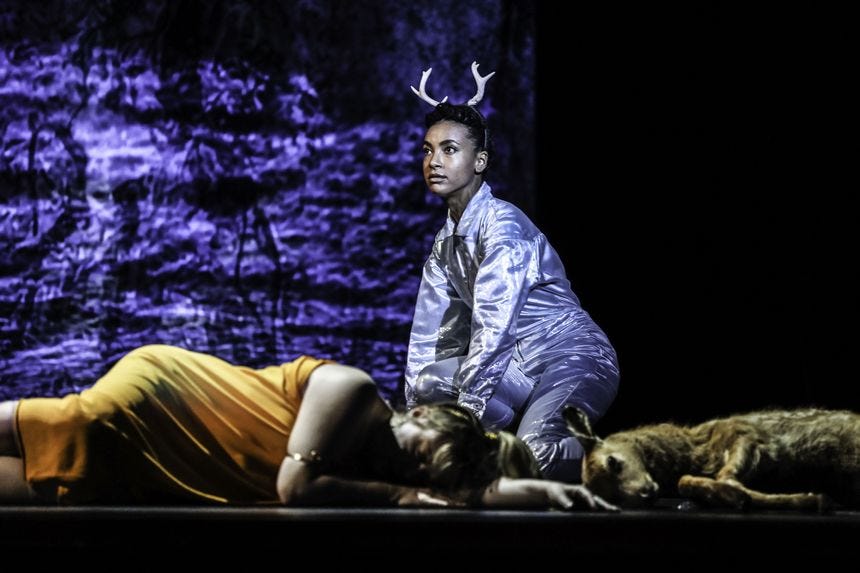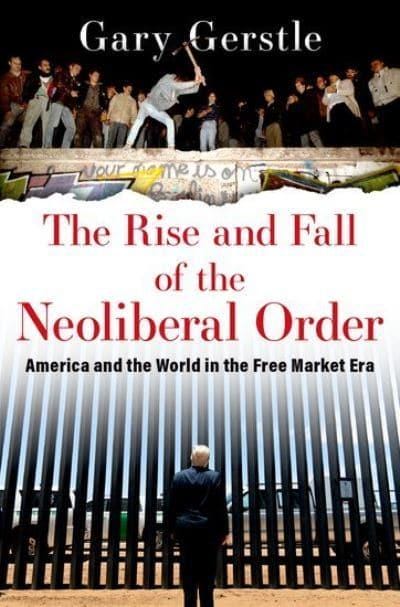Further Reading & Listening #8
Putin & Russia's elites, vibe shifts, TS Eliot & the Bhagavad Gita, the climate cliff edge, opera revolutions, technopopulism, Roy Foster & the end of the Reagan order
Thank you for supporting Fault Lines.
I hope you enjoy this week’s most diverting and thought-provoking readings, as well as a new section spotlighting some of the most original and compelling podcast conversations.
“There are no “disloyal” people left in power in Russia”
Sanctions and propaganda have rallied even those who were against the invasion around Putin
“Since they adopted sanctions against us, we’re going to f*ck them. Now they’ll have to buy rubles on the Moscow Exchange to buy gas from us. But that's just the beginning. Now we're going to f*ck them all.”
So tells me, with enthusiasm, a high-ranking Russian official. He has long been a member of Putin's team, but has been considered a liberal thinker. A month ago he had a different attitude, saying with some chagrin that the most important thing was to stop the bloodshed in Ukraine, and then to figure out how to live in the new reality.
In short, it can be said that, over the past month, Putin’s dream of a consolidation among the Russian elite has come true. These people understand that their lives are now tied only to Russia, and that that’s where they’ll need to build them. The differences and the influence of various circles and clans have been erased by the fact that, for the most part, people have lost their past positions and resources. The possible conclusion of a peace treaty is unlikely to change the mood of the Russian elites. "We’ve passed the point of no return,” says a source close to the Kremlin. “Everyone understands that there will be peace, but that this peace won't return the life we had before.”
A Vibe Shift Is Coming. Will any of us survive it?
A vibe shift is the catchy but sort of too-cool term Monahan uses for a relatively simple idea: In the culture, sometimes things change, and a once-dominant social wavelength starts to feel dated. Monahan, who is 35, breaks down the three vibe shifts he has survived and observed: Hipster/Indie Music (ca. 2003–9), or peak Arcade Fire, Bloc Party, high-waisted Cheap Mondays, Williamsburg, bespoke-cocktail bars; Post-Internet/Techno Revival (ca. 2010–16), or the Blood Orange era, normcore, dressing like The Matrix, Kinfolk the club, not Kinfolk the magazine; and Hypebeast/Woke (ca. 2016–20), or Drake at his Drakest, the Nike SNKRS app, sneaker flipping, virtue signaling, Donald Trump, protests not brunch.
Notes on where tech power is moving in the Biden years
I have been thinking about Davis’ piece more or less ever since. In particular, I’ve been working on how to apply it to my chosen field: tech journalism, which is driven as much by social wavelengths as any other part of our culture. For some time, I had been attempting to work out which stories felt relevant in 2022 that may not have in, say, 2020. Today, I want to tell you what I’ve come up with.
In short, some kinds of tech journalism has come to feel dated to me; some stories feel like they are beginning to come to their conclusion. At the same time, there are a host of new stories that need telling, thanks to shifts in power in Silicon Valley, and talented journalists are already beginning to bring them to our attention.
The most obvious reason for this shift is the change in presidents. Donald Trump’s malignant reign as president demanded one sort of coverage; Joe Biden’s quiet, pro-democracy presidency demands another. Biden doesn’t appear in Davis’ story, but on the subject of tech and tech policy, his presidency (and Trump’s social media exile) account for a significant portion of the vibe shift.
Human Kind Cannot Bear Very Much Reality
TS Eliot’s Burnt Norton & the Bhagavad Gita
From the Gita, Eliot had picked up a poetic-critical mode that impelled him to dispense with the binaries of post-Enlightenment thought and attempt a new vocabulary to suggest how poetry might best challenge those binaries. But he also learned from it not to desire a full-frontal view of “reality”; not only because “[h]uman kind cannot bear very much” of it, but because he wanted to remain a poet—that is, a kind of writer who both chooses to grasp things incompletely and also has a longing for “reality” as the commonplace: “When I see thy gentle human face, Krishna, I return to my own nature, and my heart has peace.” Towards the end of “Tradition and the Individual Talent,” too, Eliot rehearses the receding of that dramatic moment in the Gita, when Krishna returns to his familiar form: “This essay proposes to halt at the frontier of metaphysics or mysticism, and confine itself to such practical conclusions as can be applied by the responsible person interested in poetry.” “Human kind cannot bear very much reality,” yes; but “reality” is also the “practicality” of what we know and what comprises our world—the two sharp knocks on the table.
The Razor's Edge of A Warming World
If we limit warming to 1.5 degrees, these places could be saved. In a 2-degree scenario, they are lost
Julia Baum, a marine biologist at the University of Victoria, in British Columbia, has been researching climate-threatened coral reefs for years. But recently she decided to make a change. “I’ve realized the best way I can help to save coral reefs is not to work on coral reefs,” she says. “It’s to work on the energy transition.” That’s because climate change is caused chiefly by the burning of fossil fuels, which now accounts for 86 percent of carbon dioxide emissions. And unless we rapidly transition to clean energy, all other efforts to save corals—or our warming planet—won’t matter.
Around the world, profound transformations are already under way. Ski slopes are bare. Storms are worsening. Regions are becoming inhospitable for human life. In one future, the world warms by 2 degrees or more and these trends continue to their catastrophic ends. In another, we pull the hand brake now and limit warming to 1.5 degrees. “People don’t realize that every tenth of a degree matters,” Baum explains. Here are some places where they matter the most.
How opera is undergoing its most dramatic revolution in centuries
Think opera peaked 200 years ago? These artists want to change your mind
Onstage, the casual vibe persisted. Both musically and in its staging, …(Iphigenia) — the styling of the title was changed for subsequent performances — casts a critical eye on the Wagnerian-style retellings of ancient myths, foundational to many of the best-known opera works. In this version of the story — based on the Greek myth in which the title character is sacrificed to the gods by her father, Agamemnon, to improve his chances in a military campaign — the Greek soldiers are brutes swilling from red Solo cups. Helen of Troy appears, briefly, in the form of a blow-up doll. Six different actresses play versions of Iphigenia — capped off by Spalding, clad in an iridescent jumpsuit. An opera-standard pit orchestra gives way to a jazz trio at key dramatic moments; Spalding’s singing vacillates between the two styles. Whether or not the whole thing fully hangs together is an open question. “I can’t say we figured out how to do it,” Spalding said in a panel discussion following the premiere, about deciding how the story onstage would ultimately end. But this show was trying something.
The same could be said for opera writ large: Right now, it’s trying something. Like many other artistic and social spheres in the United States, the opera world has in recent years seen an influx of diverse talent and nontraditional voices. And those artists are bringing new ideas to a genre that arguably peaked in terms of mainstream cultural relevance 200 years ago.
Bungacast: Technopopulism & Toxic Politics
On the fusion of technocracy & populism
Carlo Invernizzi Accetti is interviewed by Bungacast on his book, Technopopulism, co-authored with Chris Bickerton.
This is the “new logic of democratic politics”. How are all politicians today effectively technocratic and populist at the same time? How does this distinguish our age from a more ideological age in the past? And what can be done to make politics ideological again?
Conversations with Tyler: Roy Foster on Ireland’s Many Unmade Futures
“The best history is written when we realize that people acted in expectation of a future that was never going to happen.”
COWEN: If we think of Ireland in the mid-to-late 19th century, do you think there was a path where British union with Ireland persists, is at least moderately liberal, and is permanent? Does that involve earlier home rule? Or giving Catholics access to the spoils system?
How does that look? Was it ever on the table? Was it just fantasy?
FOSTER: There are two great missed chances. One is when the Act of Union happened in 1800–1801 and did away with the old Irish Parliament. This was later seen as a great injustice, but it should be remembered that that old Irish Parliament was a very elite Protestant monopoly. Implicitly part of the promise to the Irish for doing away with their Parliament was that Catholics would be, in the phrase of the day, emancipated and be allowed to sit in British Parliament and have access to the great offices of state.
Thanks to the opposition of King George III, this was ruled out, and Catholics felt very reasonably that they had been misled and cheated. It took nearly 30 years, till 1829, under Daniel O’Connell, as I’ve mentioned, for that injustice to be rectified. There’s a very good recent book about it by Antonia Fraser. This, I think, was a missed chance for reconciliation. Those 29 years between the union of 1800 and Catholic emancipation of 1829 were suffused with bitterness, which need not have been the case.
The other great missed chance is in 1886, when Gladstone converted himself and a large part of his ruling Liberal Party in Britain to the cause of Irish home rule. In the greatest speech of his life, for nearly (I think) two and a half hours, he tried to persuade the House of Commons that if they rejected giving Ireland an autonomous parliament within the empire, indeed within the United Kingdom, they would regret it in the future and it would be a very ominous sign. They did reject it, the House of Commons. They passed it a few years later, but it was rejected by the House of Lords.
I think 1886 was probably the last moment when, conceivably, there could have been united Ireland between the increasingly different Northeast and the rest of the island, with an autonomous parliament on the Canadian model within the empire, which I suspect would have disengaged itself over the next 50 years by peaceful steps, as indeed the Irish Free State after the Irish revolution disengaged itself from the Commonwealth by peaceful steps.
But by then Ireland was partitioned, which to me is an inevitable tragedy but still a tragedy. And that could just about have been averted had Britain given Ireland home rule in 1886.
New Books in History: Gary Gerstle on The Rise and Fall of the Neoliberal Order
Ronald Reagan’s New Economic Order, and What It Meant for America
Ronald Reagan devoted his Labor Day in 1980 to two marvelous photo ops. The first captured him delivering a major speech on freedom and opportunity in Jersey City, N.J., the Statue of Liberty standing in the haze behind him. Then he flew to Allen Park, Mich., one of Detroit’s ubiquitous blue-collar suburbs, for an afternoon cookout at the modest home of a laid-off steelworker. There he got his second shot: the soon-to-be president of the United States standing over a grill packed with kielbasa, barbecue tongs in one hand, a beer in the other. The free market revolutionary as an average Joe, chatting up the workingman.
It was a marker of one of the two political transformations that drive Gary Gerstle’s enlightening new book, “The Rise and Fall of the Neoliberal Order.” For almost half a century families like those that lived in Allen Park had backed what Gerstle, the Paul Mellon professor emeritus of American history at Cambridge, calls “the New Deal order.” At its core lay Franklin Roosevelt’s commitment to using government power to counter capitalism’s instability and inequality. From that principle emerged an array of public policies, some meant to regulate troublesome sectors of the economy, others to assure the aged and the poor a minimal standard of living, still others to give working people the income they needed to buy the goods their factories produced and the homes they dreamed of owning. As the programs flowed out, the support flooded in: By 1936 Roosevelt had added a huge bloc of blue-collar voters in the urban North to the Democrats’ traditional base in the white South, a combination so powerful it gave the party almost unassailable control of national politics for two generations.
The coalition started to splinter in the mid-1960s, when Lyndon Johnson’s support of the surging civil rights movement drove the white South to the Republicans. Gerstle sees the fatal blow coming with the following decade’s economic crisis. The trouble started with the Vietnam War, which triggered an inflationary spiral that the oil shocks of the 1970s accelerated. Rising prices opened the economy to a rush of lower-cost imports that American industries didn’t see coming until it was too late. Suddenly auto plants were cutting shifts. Steel mills were shuttering. And Ronald Reagan was standing over a couple of dozen sizzling sausages, telling a yard full of struggling steelworkers that it was time to give up on the New Deal order.












